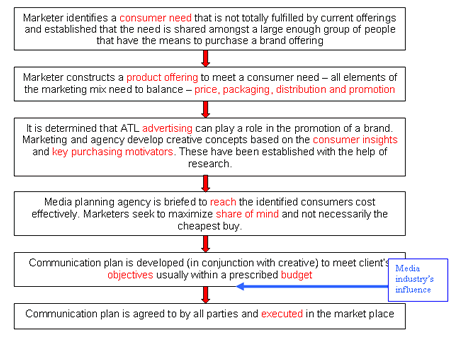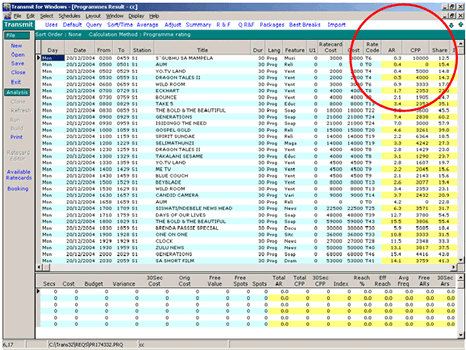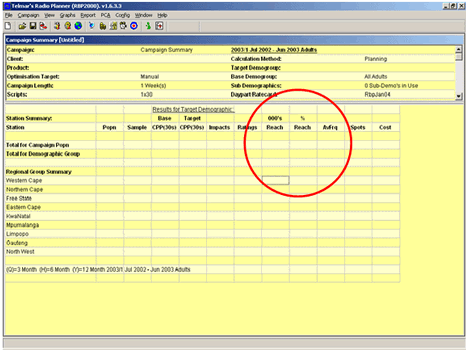19 October 2004
Joanne Scholtz
The Advertising Media Forum is a non-profit company, which provides a platform for media strategists, planners and purchasers to co-ordinate a common policy to promote acceptable standards and practices in the media industry. We strive to promote the attainment of these standards and practices by acting as an advisory and consultative body to the advertising, marketing and media industry and other relevant organisations including government organisations such as the Media Development and Diversity Agency; initiating and encouraging policies to achieve meaningful and sustained participation in the media industry by South Africans who were previously discriminated against for whatever reason; and enhancing and upgrading the quality of professionalism throughout the South African media industry.
(Additional information in Appendix A)
Where do we fit in the Marketing Value Chain?
-
The media function constitutes less than 10% of staff employed within the advertising industry.
- Brewers quote current estimates at 413 in Media vs the Advertising Industry at 4,672. This is not an accurate measure, but can be used as a guideline.
- According to Brewers information, transformation in media personnel is 3% ahead of total advertising figures, currently at 23.11%. This is a 3.5% improvement on 2001 figures presented to government
- Media: White = 305 (73.84%) PDI = 108 (26.15%)
-
AMF members aim to comply with the Labour Act legislation
-
Our revenue achieved through media placements constitute an approximate 3% of total marketing spend.
-
Our sphere of influence is predominantly on HOW the advertising media budget (between 20 - 60% of total marketing budget) is procured.
- It should be noted that marketing is moving from the traditional above-the-line spend to more diversified marketing vehicles, commonly known as below-the-line opportunities.
It is for the above-mentioned reasons that our submission will focus on advertising media budget procurement and we offer a solution on how we can plan media spend with BEE targets as a specific objective. With regards to training and transformation, we are guided by the ACA (many of our members either belong to, or are owned by ACA members) and the MFSA, of which many of our clients are members.
Advertising media procurement considerations:
-
Previous submissions have focused on the value chain and the outline is attached as Appendix B.
In summary, the value chain starts with the Client's Marketing Budget. Allocations are made to various communication channels, which include Advertising, Media, PR, Events, Sampling, Sales Promotion, Competitions, Conferences, Exhibitions, etc.
-
The average media planners or strategist is not well informed of the BEE status of media owners, as current data available within planning tools focus on the audience a medium is attracting. Fundamentally, our task is to seek out the most cost effective means of targeting a commercial message to a clearly identified audience. For example, a large media company will own several media titles/stations across various media platforms and these titles may reflect different ownership credentials e.g. Primedia, the ownership of 702 is 19.5%, whereas its ownership of 94.7 Highveld stereo is 67.8%.
- Perceptions of media titles being empowered are also incorrect, and while one may be targeting a black audience with a relevant magazine title, one may find that empowered ownership thereof is very light or vice versa, a title may be perceived as white, while it may have a very high BEE score (e.g. Sunday Times).
Our proposed solution
Our aim is to motivate for the development of an analysis tool that will reflect the BEE criteria/score of each individual title used within the communication planning process. This would be in addition to the existing tools that provide measurement data on schedule performance such as reach, frequency, cost per thousands, impact, duplication etc. Such a tool/module is to be developed, in conjunction with other relevant parties such as ACNielsen, Telmar and IMS.
The formulation of such a tool is currently in the planning phase. The dynamics of such a tool have been investigated and are deemed possible by the current planning tool software providers.
Solution considerations:
Many questions have been posed. The development process will require experts to consider them and deliver a suitable solution.
1. The score
- Does this information already exist? An independent third party may have to be contracted to develop a BEE ownership score by media title and this could be consolidated into media ownership by holding company.
- Could we use Empowerdex?
- Should the score be based on money spent, or on ratings (ratings illustrate the performance of the publication against a defined audience) purchased? How do discounts affect the score? Should published rate cards be used as the primary criterion?
- Consider the score a weighted component in AMPS? [Literally have a score alongside Reach (Percentage coverage of the defined target audience) and Frequency (Average number of times that target audience are exposed to the message)]
-
Updating and tracking of BEE changes should be done at regular intervals to ensure that data is relevant and reflective of the market at the time of exposure.
2. Funding
-
Should the Media Owners pay a small fee for the BEE Score used by specific titles/stations/etc. in the planning tools?
-
Could Government sponsor the cost? Could one consider a special levy on Government media spend?
-
This tool may become the government certificate of BEE status within the media industry. (Similar to the ABC of print circulation, the standard measurement used to verify sales figures.)
-
This tool may become the government certificate of BEE status within the media industry. (Similar to the ABC of print circulation, the standard measurement used to verify sales figures.)
-
Keeping the data up to date will add to the running cost of this tool. There are constantly new additions to the media industry, as well as constant change in the empowerment levels.
3. How planning currently works - simplified to illustrate only:
- A typical media schedule demonstrates levels of Reach (how many people within the defined target market are reached) and Frequency (how many opportunities the defined target market will have to "see" the commercial) achieved. A media planner's goal is to achieve optimal Reach and Frequency at the best possible price.
- Alongside the science of media, affinity to the target market and other softer variables are also considered, prior to finalising the media plan and implementing the schedule.
-
Screen prints of existing tools attached in Appendix C
4. The change in output - simplified:
- Alongside Reach and Frequency, a new variable will be placed demonstrating the BEE score in the planning phase. Pro-active changes will be possible to ensure that BEE procurement objectives are achieved with the media schedule. Once optimal Reach, Frequency and BEE scores have been achieved, the media plan can be finalised before implementation.
-
Fundamentally, media planning will change in SA. An additional dimension will be added to the process.
5. Implications and benefits
- Optimal BEE procurement
-
Pro-active influence on procurement versus re-active monitoring of how money has been spent.
6. Accountability
- Ultimately approved by client, who is accountable for the money spent.
- The advertising media industry makes recommendations to clients and the clients may choose to ignore these recommendations. The media planner/strategist can only influence advertising media spending, not dictate it.
AMF Engagement
-
Government:
We would welcome an individual, appointed by Government, with the sole objective of understanding our industry, the way it works and the issues we face within our profession. The AMF offers to amend its constitution in order to offer Government an automatic membership to our elected Board. This member seat will have observer status at an executive level and will be party to all our debates and deliberations.
-
Media Industry
Our new constitution has been developed around more inclusive membership criteria. We have an open-ended charter. Membership is voluntary and requires commitment and work outside of the individual's permanent employ.
-
Advertising education bodies
The Charter of the AMF specifically precludes the organisation from running formal training programmes. By long standing mutual agreement, education is the domain of the Advertising Media Association of SA (AMASA). Many senior members of the AMF serve (or have served) on both bodies. The AMF lobbies on technical media planning issues, whereas AMASA concentrates its efforts on training and upliftment. The AMF contributions to AMASA and other education bodies are:
- In the form of lecturing, at AMASA approved programmes including the AMASA workshops, AAA school of Advertising, Boston House College and The University of Johannesburg.
- The setting and marking of examination papers for the annual exam for the formal AMASA/ AAA diploma course. On Thursday 14 October 2004, 67 students wrote an examination set by a member of the AMF, based on the media textbook written by a member of the AMF and the marking of those exam papers was conducted over the weekend, and delivered on Monday 18 October, by a member of the AMF.
- The textbook, "Media Planning - Art or Science", widely used by tertiary institutions across South Africa and Africa, was written by a member of the AMF, who, in the interests of industry co-operation has ceded the copyright of the book to AMASA. The textbook is the primary revenue source for AMASA's EE bursary programme.
- The AMF and AMASA have engaged with bodies such as the MDDA with regards to their development programme and have offered our time and commitment through lecturing on the topic of advertising media.
- The AMF has presented advertising media introduction lectures to Vista University on the Mamelodi, Soweto & East Rand campuses
Note: Media planning is a module within the advertising education curricula. Students select their field of choice once formal education is complete. Interns are recruited to learn media in-depth as part of the media training process.
-
Relevant industry bodies
The AMF continue to engage with bodies such as the MFSA's media committee with regard to issues pertaining to media rate inflation and media research tools. We are instrumental in supplying inputs into the South African Advertising Research Foundation, who annually conduct the AMPS survey. We also provide time and intellectual inputs into the people meter (TAMS) and RAMS diary research surveys.
Appendix A: Background information on the AMF
Who are we: -
The Advertising Media Forum is a non-profit company which provides a platform for media strategists, planners and purchasers to co-ordinate a common policy to promote acceptable standards and practices in the media industry. We previously addressed this forum under the auspices of the Media Directors Circle.
The AMF was formed to:-
- Be more inclusive: To encourage and empower new talent and leaders from amongst those responsible for the day-to-day planning and purchasing of media, to take an active role in steering our industry into the future. The media profession does not operate in isolation. We aim to forge relationships and build bridges with other industry bodies such as MFSA, ACA, the Creative Circle, AMASA and to encourage them to play their role in the transformation process.
- Encourage transformation: To actively participate in the transformation process of our industry by: attracting new talent into the media planning and buying industry particularly those from previously disadvantaged communities; encouraging training and retention programmes amongst our members; and by removing any discriminatory practices within our profession.
- Encourage Professional practices: With a stronger organisational constitution, a members' code of conduct and a committee responsible for ethics, we hope to encourage our members ( as well as the broader media industry), to adhere to the highest standards of media planning and buying practices.
- To be an industry watchdog: To play the role as watchdog within our industry by encouraging transparent and justifiable sales polices, pricing strategies and transactions amongst media owners.
Appendix B
The communication Value Chain

Although we are the key inter-face with media owners, many of the important strategic, targeting and creative decisions are made further up the value chain.
Appendix C

Proposed tool will add a new dimension to the existing variables available to planners. An additional column would be provided similar to those circled for illustration


